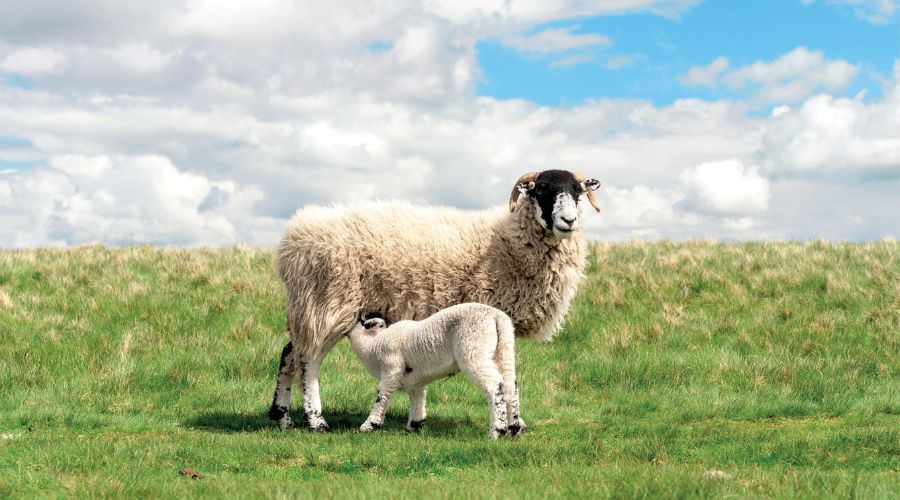Could your production losses be down to ovine Johne’s disease?
27th March 2025
Johne’s disease is often missed in sheep, but can cause serious production losses. Sarah Kidby spoke to experts about cost-effective control.

The fertility issues and progressive weight loss seen with Johne’s disease are often missed or attributed to other issues in sheep – such as nutrition or parasites. There is also a lack of awareness around the availability of cost-effective testing.
The latest data from the University of Liverpool shows between 70–80% of UK flocks are infected with Johne’s, and between 9.5% and 33% of animals within flocks are infected, said Dr Peers Davies, a reader in livestock health and welfare at the university.
Sheep farmers are far less aware of the disease than cattle farmers, which is partly down to the fact that, unlike cattle, infected sheep do not scour and there are no obvious or specific signs of the disease.
Progressive weight loss and scanning empty are key early signs, but ewes are often culled before they become critically ill, so they never get to the stage where they look visibly diseased, Peers explained. And being an iceberg disease, many animals will be shedding bacteria, underperforming and costing money without showing any signs of disease.
The barren rate is often put down to bad luck, poor weather, age or other factors, and testing for Johne’s and other production limiting diseases is not carried out – partly because vets have not been proactive in making farmers aware it can be done.
If left unchecked in a flock, Johne’s can have production limiting effects such as reduced fertility, lower lambing percentages and earlier culling of ewes, resulting in a younger flock and lost lamb crops, said Kate Ingram, Virbac UK technical adviser (ruminant).
Ewes may also have increased susceptibility to other diseases, such as mastitis, and reduced quality or quantity of milk so that lambs take longer to reach their weaning weights. Ewes may be culled due to chronic mastitis, without Johne’s necessarily being considered as a cause, she added.
Peers noted that farms often compare scanning rates between themselves, but not replacement rates – and monitoring this could help to identify Johne’s.
Testing is a key tool in the armoury, and Peers recommends pooled faecal PCR samples as the most effective screening method. There is government funding available for this under the Animal Health and Welfare Pathway.
How to test
The best way to test is to select 30 adult breeding ewes, ideally including thin cull ewes, but a random sample is fine, and divide them into six groups of five. Take faecal samples from each of those five and pool them together. The six pools of five animals is then tested by the APHA.
This approach of using the faecal PCR test is done in Australia where Johne’s is well recognised and has been successfully controlled for some time.
Blood tests are also available – these are not sensitive enough for screening but can be used to test individual animals displaying clinical signs of severe weight loss.
Prevention
It’s impossible to eradicate Johne’s as the bacteria is so stable in the environment, but long-term, cost-effective control is very possible, Peers noted. It’s the only iceberg disease with an effective vaccine and there is good evidence from Australia to support its efficacy.
There is uncertainty over the efficacy of other mitigation strategies, however – and some, such as feeding higher plane nutrition, are costly, so vaccination remains the best tool, he continued.
Gudair is a single dose vaccine, with no boosters needed, and it’s licensed for sheep and goats, explained Kate. It should ideally be administered between four weeks and six months of age, to animals you plan to keep, such as replacement ewe lambs and ram lambs, to protect your breeding stock going forward.
The vaccine delays the onset of clinical signs, reduces the severity of clinical signs, reduces shedding and delays the onset of shedding – prolonging the productive life of the sheep. Whilst an investment, it’s a one shot vaccine for life and if you can get an extra lamb crop out of your ewe then you should have easily paid for the vaccination, Kate added.
Other measures of prevention revolve around trying to reduce the level of exposure for lambs – it’s generally spread by the faeces of infected animals that are actively shedding, so higher risk ewes should be kept away from lambs, and muck from animals with Johne’s should not be spread on the fields.
There can also be cross-contamination from cattle if you’re co-grazing, Kate noted. However, strategies such as snatch lambing will not be suitable for sheep, so vaccination is a key control measure.
Key take-home points, Peers concluded, are recognising and testing for Johne’s in the appropriate way, then when it’s confirmed, vaccinating and calculating your own costs to determine how much you will potentially save through vaccinating.



